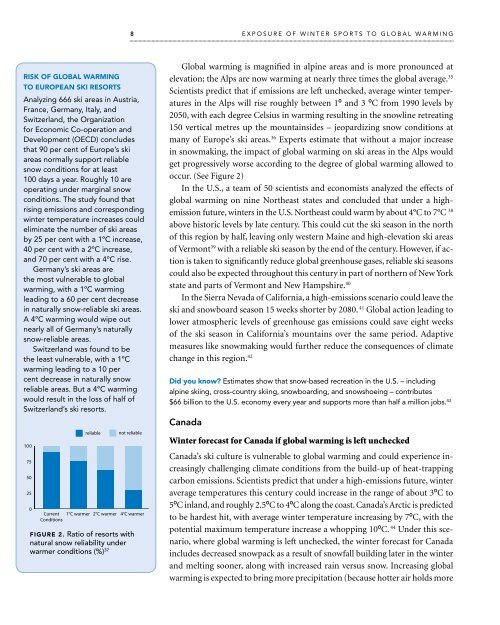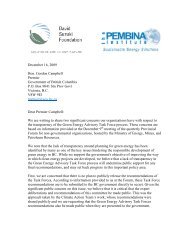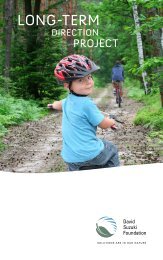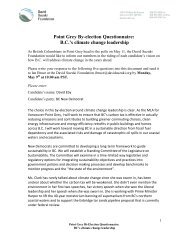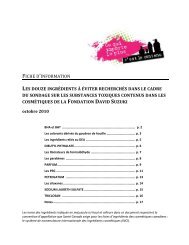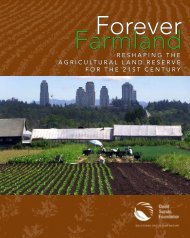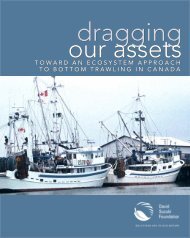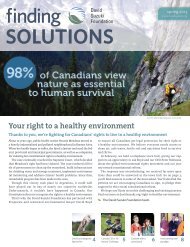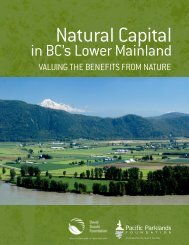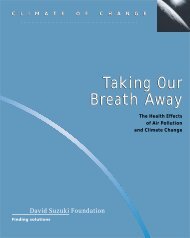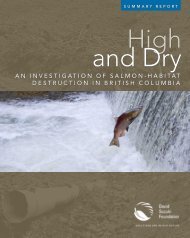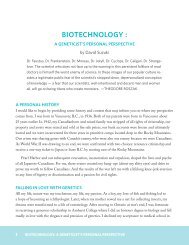On Thin Ice: Winter Sports and Climate Change - David Suzuki ...
On Thin Ice: Winter Sports and Climate Change - David Suzuki ...
On Thin Ice: Winter Sports and Climate Change - David Suzuki ...
You also want an ePaper? Increase the reach of your titles
YUMPU automatically turns print PDFs into web optimized ePapers that Google loves.
ISk OF GLOBAL WArmING<br />
TO EurOpEAN SkI rESOrTS<br />
analyzing 666 ski areas in austria,<br />
france, germany, italy, <strong>and</strong><br />
switzerl<strong>and</strong>, the organization<br />
for economic co-operation <strong>and</strong><br />
development (oecd) concludes<br />
that 90 per cent of europe’s ski<br />
areas normally support reliable<br />
snow conditions for at least<br />
100 days a year. roughly 10 are<br />
operating under marginal snow<br />
conditions. the study found that<br />
rising emissions <strong>and</strong> corresponding<br />
winter temperature increases could<br />
eliminate the number of ski areas<br />
by 25 per cent with a 1ºc increase,<br />
40 per cent with a 2ºc increase,<br />
<strong>and</strong> 70 per cent with a 4ºc rise.<br />
germany’s ski areas are<br />
the most vulnerable to global<br />
warming, with a 1ºc warming<br />
leading to a 60 per cent decrease<br />
in naturally snow-reliable ski areas.<br />
a 4ºc warming would wipe out<br />
nearly all of germany’s naturally<br />
snow-reliable areas.<br />
switzerl<strong>and</strong> was found to be<br />
the least vulnerable, with a 1ºc<br />
warming leading to a 10 per<br />
cent decrease in naturally snow<br />
reliable areas. But a 4ºc warming<br />
would result in the loss of half of<br />
switzerl<strong>and</strong>’s ski resorts.<br />
100<br />
75<br />
50<br />
25<br />
0<br />
reliable<br />
Current<br />
Conditions<br />
1°C warmer 2°C warmer 4°C warmer<br />
8 exposure of winter sports to gloBal warMing<br />
not reliable<br />
FIGurE 2. ratio of resorts with<br />
natural snow reliability under<br />
warmer conditions (%) 37<br />
Global warming is magnified in alpine areas <strong>and</strong> is more pronounced at<br />
elevation; the Alps are now warming at nearly three times the global average. 35<br />
Scientists predict that if emissions are left unchecked, average winter temperatures<br />
in the Alps will rise roughly between 1º <strong>and</strong> 3 ºC from 1990 levels by<br />
2050, with each degree Celsius in warming resulting in the snowline retreating<br />
150 vertical metres up the mountainsides – jeopardizing snow conditions at<br />
many of Europe’s ski areas. 36 Experts estimate that without a major increase<br />
in snowmaking, the impact of global warming on ski areas in the Alps would<br />
get progressively worse according to the degree of global warming allowed to<br />
occur. (See Figure 2)<br />
In the U.S., a team of 50 scientists <strong>and</strong> economists analyzed the effects of<br />
global warming on nine Northeast states <strong>and</strong> concluded that under a highemission<br />
future, winters in the U.S. Northeast could warm by about 4°C to 7°C 38<br />
above historic levels by late century. This could cut the ski season in the north<br />
of this region by half, leaving only western Maine <strong>and</strong> high-elevation ski areas<br />
of Vermont 39 with a reliable ski season by the end of the century. However, if action<br />
is taken to significantly reduce global greenhouse gases, reliable ski seasons<br />
could also be expected throughout this century in part of northern of New York<br />
state <strong>and</strong> parts of Vermont <strong>and</strong> New Hampshire. 40<br />
In the Sierra Nevada of California, a high-emissions scenario could leave the<br />
ski <strong>and</strong> snowboard season 15 weeks shorter by 2080. 41 Global action leading to<br />
lower atmospheric levels of greenhouse gas emissions could save eight weeks<br />
of the ski season in California’s mountains over the same period. Adaptive<br />
measures like snowmaking would further reduce the consequences of climate<br />
change in this region. 42<br />
Did you know? estimates show that snow-based recreation in the u.s. – including<br />
alpine skiing, cross-country skiing, snowboarding, <strong>and</strong> snowshoeing – contributes<br />
$66 billion to the u.s. economy every year <strong>and</strong> supports more than half a million jobs. 43<br />
Canada<br />
<strong>Winter</strong> forecast for Canada if global warming is left unchecked<br />
Canada’s ski culture is vulnerable to global warming <strong>and</strong> could experience increasingly<br />
challenging climate conditions from the build-up of heat-trapping<br />
carbon emissions. Scientists predict that under a high-emissions future, winter<br />
average temperatures this century could increase in the range of about 3ºC to<br />
5ºC inl<strong>and</strong>, <strong>and</strong> roughly 2.5ºC to 4ºC along the coast. Canada’s Arctic is predicted<br />
to be hardest hit, with average winter temperature increasing by 7ºC, with the<br />
potential maximum temperature increase a whopping 10ºC. 44 Under this scenario,<br />
where global warming is left unchecked, the winter forecast for Canada<br />
includes decreased snowpack as a result of snowfall building later in the winter<br />
<strong>and</strong> melting sooner, along with increased rain versus snow. Increasing global<br />
warming is expected to bring more precipitation (because hotter air holds more


